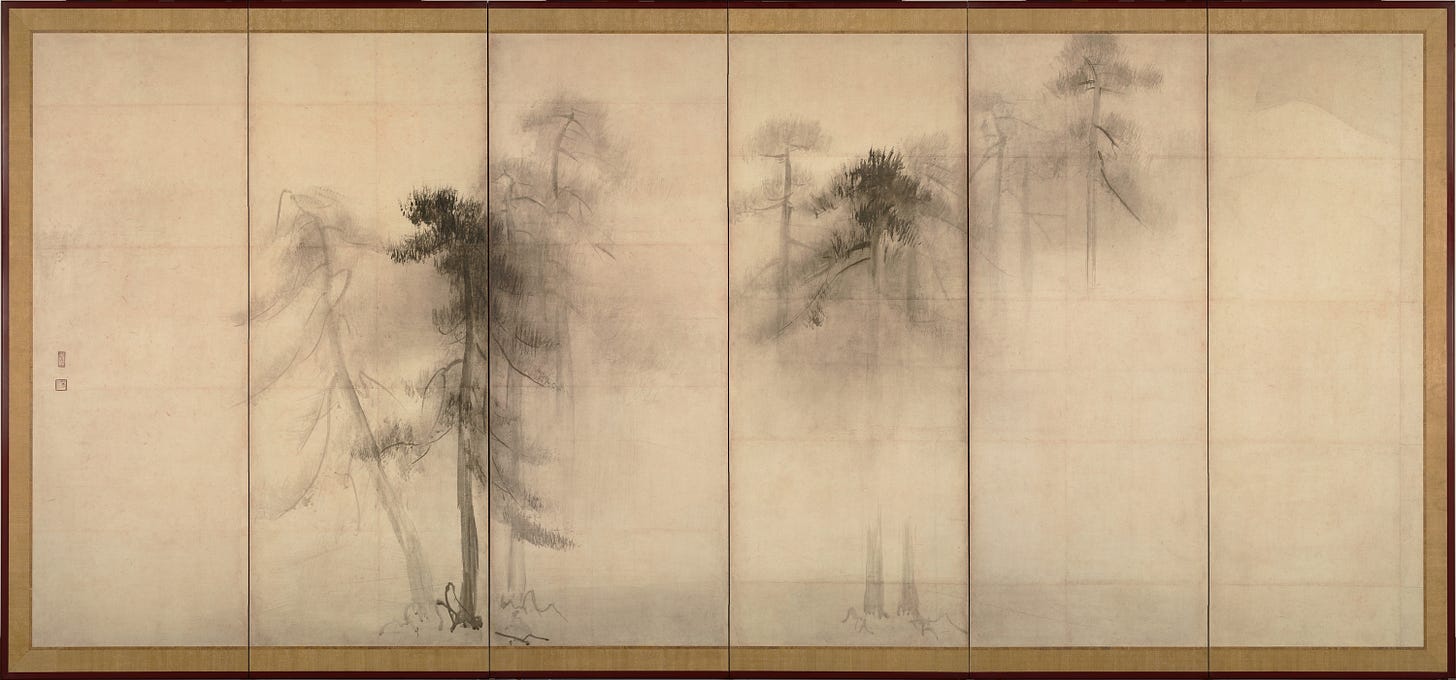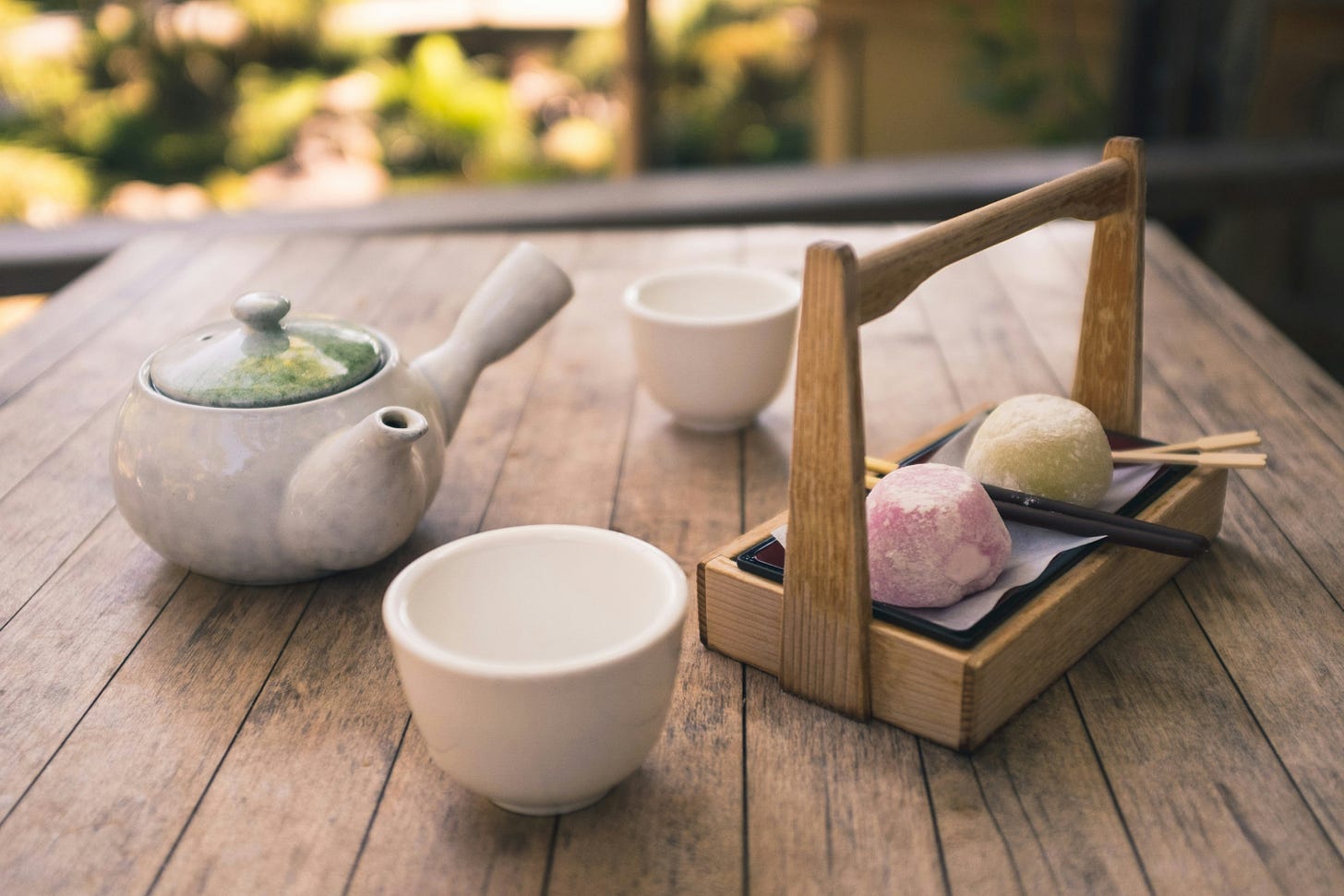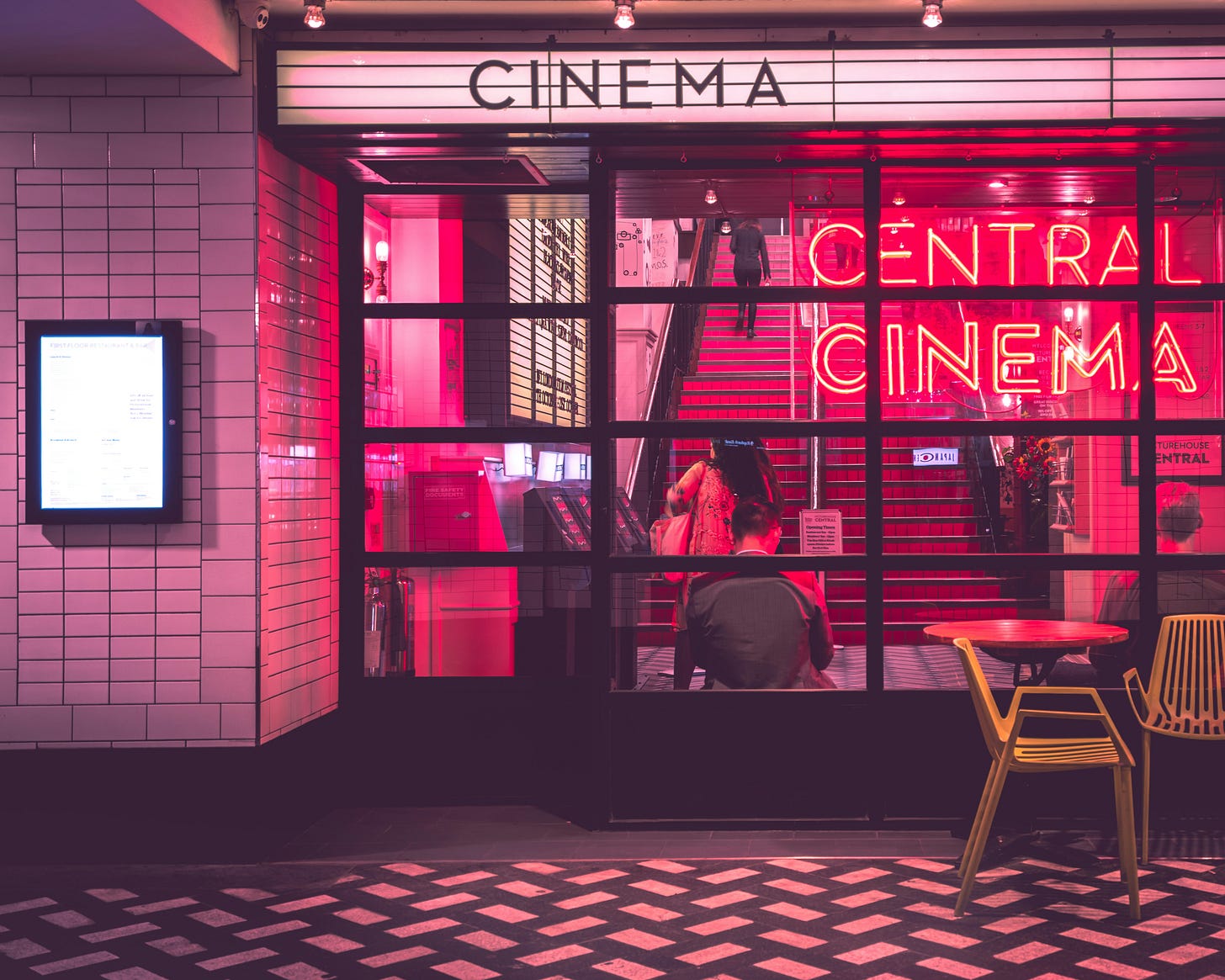The Power of Silence, Stillness and Space in Storytelling — and in Life
What can we learn from the concept of "Ma" in Japanese culture?
Every morning at 9am, a white-haired man arrives at an unassuming vine-covered building in Koganei, Tokyo. Although he is always first to get there, he makes sure to walk around shouting “good morning” to all of the empty rooms. He believes that unseen residents live in them.
Next, he drags a bench to the front of the building and places a sign on it saying, ‘Take A Seat’. He doesn’t sit on this bench. Instead, he makes pour-over coffee and watches from a window, curious to see if any of the arriving workers sit on it.
Next, he draws manga for fun for a while. Sometimes, he leaves the building, attaches a video camera to his car and drives around aimlessly, filming roads and passers-by. After returning to the vine-covered building, he starts work, pausing occasionally during the day to watch scenery or clouds.
Sometimes, he sweeps the grounds. Sometimes, he chops wood for the Vermont cast-iron stove. He tends to have lunch — usually ramen noodles — around 3pm. He stays at the premises for 12 hours, Monday to Saturday, leaving at 9pm each night.
Who is this man? A caretaker? Security guard? Eccentric office worker? No, he is Hayao Miyazaki, chairman of Studio Ghibli and director of Spirited Away, Howl’s Moving Castle and My Neighbour Totoro. What I’ve just described is his creative process.
Of course, I’ve only sketched out parts of Miyazaki’s routine at Studio Ghibli. During his 12-hour days at the anime studio, he also does what you might expect: hand-draws animation frames (sometimes up to 80,000 per film). Oversees a team of 190 people, including background artists, composition artists and animators. Storyboards his films, allowing plots and characters to reveal themselves gradually.
But those in-between moments — of driving around aimlessly, gazing at clouds, sweeping the studio lot — are what Miyazaki might call “Ma” moments. They are central to both his artistic process and his approach to storytelling, for he inserts them into his films too. But what is “Ma”?
Ma — the empty spaces between action
Wind blows across grass. A snail crawls up a plant stalk. A girl fans herself on her bed while a breeze ruffles the curtains. A man smokes a cigarette by a bedroom window. A girl does homework at her desk. Two friends stand in pouring rain at a bus stop, holding umbrellas. A girl with a red ribbon in her hair lies in a field, gazing up at the sky.
In Miyazaki’s Studio Ghibli movies, he tries to include moments of characters doing quiet or uneventful things like these. This could be gazing at a river, riding a train in silence or even switching on a lamp. He calls this Ma.
In an interview with Miyazaki, film critic Roger Ebert asked him about these moments. Miyazaki clapped his hands several times and said:
“The time in between my clapping is Ma. If you just have non-stop action with no breathing space at all, it's just busyness. But if you take a moment, then the tension building in the film can grow into a wider dimension. If you just have constant tension at 80 degrees all the time you just get numb.”
Miyazaki continued speaking while clapping slowly:
“Western animators are afraid of ma. They think you have to keep making the sound of the clap, or you will lose your audience. I disagree; I think if you fill ma with thinking, emotion and intention, you will not lose your audience.”
Japanese aesthetics and Ma
In Japanese, “Ma” translates as “space”, “emptiness” or “interval”. Yet Ma is about more than the space between things, it is also about the intention and meaning in those spaces. Think of it as the silence between music notes or the white space around a tree in a painting.
In the culture and aesthetics of Japan, absence is as important as presence. This is expressed in art, architecture, music and even tea ceremonies, where the creation of negative space is central to the experience.
“The tea-house can be described as the space of emptiness; and indeed, it is a virtually empty space when the guest opens the very small and low door to enter for the first time. The initial impression is simply space, with almost nothing in the space.”
Jack Convery, Japanese Tea Master
When you reach the garden walkway leading to the entrance of a Japanese tea house, it’s designed to look like a winding mountain path. This effect is created through the inclusion of stepping stones, as well as trees and plants commonly found on mountains. In this way, the teahouse represents a place of shelter where a weary traveller can pause before continuing on their journey. It is an empty space, a break in the narrative, a chance to embrace Ma.
Likewise, Miyazaki uses Ma moments as breaks within the “winding mountain path” of his stories. They create rhythm in his movies and avoid viewers being numbed out by constant action. He believes that you can’t have successful emotional peaks in a film without also including crucial breathing space moments of silence or stillness.
In Studio Ghibli movies, this absence is expressed in scenes that don’t really advance the story. At those times, the plot has essentially paused and instead, we get to see characters experiencing their reality in the moment. For instance, gazing over a meadow or smoking a cigarette by a window. Sometimes they are processing what has happened to them so far, sometimes they are preparing for what’s to come, and sometimes they are simply existing.
As Ebert observes about Miyazaki’s films:
“Instead of every movement being dictated by the story, sometimes people will just sit for a moment, or they will sigh, or look in a running stream, or do something extra, not to advance the story but only to give the sense of time and place and who they are.”
Ma inserts can last anything from a second to a few minutes. Yet even those scenes that only last a second or two can have an impact. Take Studio Ghibli’s Whisper of the Heart (1995), written by Miyazaki and directed by Yoshifumi Kondō. In an early scene, we follow the main character, Shizuku, on her walk to school. It’s a bright day and when she glances up to see a flash of sunlight hit an electricity pylon, the moment seems to fill her with quiet joy.
This scene has two effects: it makes us feel closer to Shizuku, for we have enjoyed a simple, private and highly specific moment with her. It also encourages us to pay attention to the small moments of beauty in our own lives — to appreciate a flash of sunlight on an “ugly” or industrial object like a pylon.
Like other Studio Ghibli movies, Whisper of the Heart is filled with scenes like these. We watch Shizuku studying at her desk, gazing at the view from her school rooftop, and walking home at night with a boy. We get scenes of sunrise and sunset over the city, of rainy days, of feet walking along the street. Together, they accumulate to make the characters and their world feel more immediate and real. As a result, we become more invested in the gentle teen love story at the heart of the movie.
Ma is cinematic emptiness — not in the sense of being a blank frame but in the sense of being a scene that refrains from advancing the plot. Instead, it invites you to step into a space of intimacy and contemplation with the characters.
Ma moments in cinema are not so much linear as they are relational: they’re about our relationship with the character’s inner world, with their surroundings and scenery, and with the film itself. Ma reveals characters and worlds to us, not through words or significant actions, but through intimate moments of simply being.
Ma says: “The moment is your home. Will you come inside and rest here for a while?”
The hollow hyperventilation of Hollywood
Ma seems to be absent from much of Hollywood cinema these days. Often, when I watch a Hollywood movie, it feels like a breathless rollercoaster from one scene to the next. This thing happens and then this thing happens and then this thing happens and then — boom! A starship has blown up or a tsunami has crashed over a skyscraper. I sometimes long for a chance to simply be with the characters while they do, well, nothing.
Sure, you will have moments of traditional pacing in Hollywood movies — quiet or romantic scenes amidst the action or drama — but those will often be dialogue-filled and they’ll be there to advance the plot. Ma they are not. Because while a Ma scene creates pacing, it’s not about moving the plot forward.
In his interview with Ebert, Miyazaki said:
“The people who make the movies are scared of silence, so they want to paper and plaster it over…they’re worried that the audience will get bored. They might go up and get some popcorn. But just because it’s 80 percent intense all the time doesn’t mean the kids are going to bless you with their concentration.”
In the most recent Star Wars trilogy, I just wanted the characters to stop for a moment, exhale and — I don’t know — gaze over a twinned-sunned alien desert in silence for a while. Or sit sipping some weird green drink in an alien cantina. Or contemplate the vastness of space through the porthole of a starship. I wanted to spend empty time with them but they refused to be still.
Hollywood cinema sends us the message that life is a breathless obstacle course you have to battle through to reach your goal. There is no room for silence or stillness because if you pause, someone else might overtake you in the race. It also sends the message that there is no value or beauty in the ordinary or mundane moments of life. Ma in cinema disrupts these messages, inviting us to stop, breathe and notice.
Ma in non-Japanese movies
When I think of some of my favourite films, they all make space for Ma. I suspect that’s a big part of why I love them.
I enjoy following Lost in Translation’s aimless tourist Charlotte as she wanders around Kyoto, walking across stepping stones and pausing to watch a wedding. I like watching lonely housewife Hunter in Swallow, sipping coffee on her balcony while gazing at the ocean. And I like watching The Station Agent’s misanthropic trainspotter, Fin, wandering along disused rail tracks. These moments deepen my attachment to the characters and help me to understand them better.
When a film allows itself to breathe — and lets me watch it breathe, when it opens itself up to me intimately — I’m much more likely to fall in love with it. I might feel that I want to stay with the characters forever, following them around as they live out their mundane, everyday lives. I don’t want these movies to ever end.
Ma’s purpose in cinema
Miyazaki makes room for Ma as he knows it’s crucial to good storytelling, which is why its absence from much of Hollywood is a huge loss. Overall, I’d think Ma has at least four purposes in cinema: pacing, characterisation, aesthetics and contemplation.
Pacing
Ma creates a much-needed resting space before climactic scenes and emotional crescendos. It prevents audiences from becoming numbed out by too much action and drama. It’s a cool gulp of water by the side of the road before the last leg of the marathon.
Ma gives us a moment to reflect on a character’s unfolding story alongside them. We get to take stock and ponder how far they’ve come — and where they might go next. Without these pauses, an unfolding plot might start to feel noisy and relentless (and perhaps even a little too desperate for attention).
Characterisation
Ma also helps us to understand characters better, as we get to see them simply living life or experiencing quiet reveries. In Ma moments, characters aren’t revealed by dialogue or by actions that drive the plot forward, they are revealed in moments that are mundane, contemplative, or both.
As author C.M. O’Brien observes in the Nocturnal Mind blog: “It’s a moment of ‘peace’ (though not always literally peaceful) for your characters to be wholly and unapologetically themselves.”
Aesthetics
Additionally, Ma offers artists and animators the chance to fully express the beauty of scenery, setting and small details, without the distractions of action or dialogue. In a Ma scene, viewers can take a break from the story and immerse themselves in a flower meadow, a twinkling city skyline at night, or even a colourful bowl of ramen. In a wider sense, they can experience the aesthetics of Ma itself — the space, the interval, the stillness.
Contemplation
Studio Ghibli’s Ma moments are meditative, even when they only last a second or two. They invite us to notice our surroundings, embrace the moment and take pleasure in soothingly repetitive tasks like making coffee or sewing a hat. They show us the value of sunlight glinting off a pylon, a plane gliding across the sky, or rain pattering on a window. Life is made up of these moments, yet they are easy to miss.
Miyazaki’s masterful Ma moment
If there is one Studio Ghibli moment that encompasses the spirit of Ma, it’s arguably the train scene in Spirited Away.
A 10-year-old girl named Chihiro is travelling on a strange train through the spirit world. As it passes over an ocean, we share the view with her, taking in scenery and brief glimpses of shadowy beings going about their existence. The train chugs along, clouds drift above, and the world slowly darkens outside the windows. All the while, Chihiro sits quiet and still, deep in thought. This is our chance to exhale and simply be with her.
Audiences love Miyazaki’s train scene — they’re not bored by it, they’re enchanted. Here is a director who trusts his viewers in a way that some of his Hollywood counterparts do not. Crucially, the scene takes place before a key emotional moment in the film, one made all the more powerful by the quiet train ride beforehand. It is like a pause in a piece of music before an orchestral soar. In the words of Miles Davis, ‘Silence is more important than sound.’
With Ma, we get to know a character in a deeper, more intimate way: this is how they eat noodles, this is how they tie their shoes, this is how they gaze at a waterfall (this is how, perhaps, they sweep a studio lot or chop wood for a Vermont cast-iron stove). This is how they are, in silence, stillness and emptiness.
As Fiona Herzog explains in 34th Street Magazine:
“In a Miyazaki film, time is granted to allow the characters to live. Characters interact with their world, and pushing the storyline is a byproduct. In Ponyo, time is given to Ponyo fumbling through a task as simple as making instant ramen…No action is considered a waste of time. A breath exhaled, hair tucked behind the ear, fidgeting hands all add to the humanity of each character, ensuring their world is rich with life.”
Ma’s purpose in daily life
Ma in movies also models how, by embracing silence, stillness and emptiness, we can deepen our relationship with our own lives. For instance, we can take time to pause, reflect and make sense of our unfolding stories. We can make space for rest before life picks up pace again. And we can appreciate both the quiet beauty of our surroundings and the charm of ordinary or “mundane” domestic routines.
For me, life seems to make the least sense when I have been too busy for too long. My days might be filled with activity but I feel increasingly empty. Yet interestingly, when I allow myself “empty” moments of stillness and silence, they fill me up. We need Ma, just like we need breathing. Ma is a space for the soul to breathe.
I want to embrace more Ma moments in my life. I want to watch a pot of vegetable soup rising slowly to a simmer, without needing the distraction of a podcast playing in the background. I want to watch waves roll in and out across a beach, without feeling I ought to be doing something more useful. I want to gaze out the window of a train for hours and not once feel tempted to pick up my phone.
And yet, I am afraid of stillness, silence and of emptiness. Not because I find it boring, although my brain will insist that this is the case. No, I’m afraid of the inconvenient feelings, fears and memories that might flood into that silence.
Don’t feel, the culture says, and I obey.
And I am afraid that if I’m not always doing, doing, doing, I might always be failing, failing, failing. Even worrying feels like a productive activity because if I’m worrying about something, like money, then I’m not taking my eyes off it. This means it can’t sneak up on me unawares.
Don’t stop, the culture says, and I obey.
And I am also afraid that, in Ma moments, I might become more aware of the Creator. Of how happy he is to sit quietly with me while the planet spins. Of how he doesn’t need me to do or be anything in those moments. Ma — the interval, the stillness, the silence — is where I might start to sense that infinite, burning love. But the trouble is, I don’t feel worthy of it.
Don’t feel worthy, the culture says, and I obey.
What if I am worthy, though? Of silence, of stillness, of a moment with the infinite? What if you are too? What if we both are?
Miyazaki’s gift is showing us that Ma is waiting to be woven through our days like a golden thread. A shimmering strand leading through the maze of confusion, drama and distraction into the space where our true selves are waiting.
What are your favourite Ma moments in cinema? Let me know in the comments below.
The Beckoning is a Substack about stories and it’s supported by you. If you’d consider subscribing, sharing this post or buying me a coffee, I’d be immensely grateful.
If you liked this post then you might like Warning from a Tiny Doppelganger, Three Strange and Mysterious Stories from Suffolk and E is for Enchantment.














That’s fascinating! I hope you’ll share more thoughts on Ma as I’d like to learn more, especially about how it benefits women writers.
There is much more here than at first meets the eye. Deborah Bell has touched on much that bears on living a life that matters; with the strokes of her pen (or keyboard as the case may be) she whisks us away from the everyday noise, and within the stillness of which she writes beckons us to find ourselves in the stories we entertain and attend to and in the world we inhabit in what we label as reality. Well worth taking the time to read and act upon should you find merit.